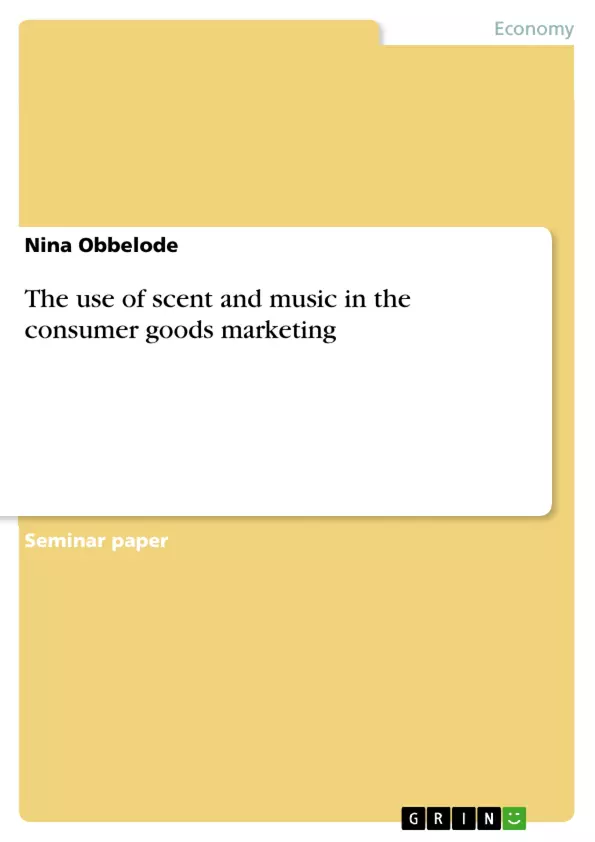“The mind is like an iceberg, it floats with one-seventh of its bulk above water” (Sigmund Freud, psychologist).
According to Freud’s quotation, the main part of the mind is beneath the water and is called the subconscious. That means people are sometimes in a certain mood, think and act automatically without knowing the reasons. Wants arise from the subconscious mind; and manipulating the customer’s wants is exactly what marketing experts in department stores would like to achieve. So the question is, if there are possibilities to influence the client’s shopping habits in order to maximise the profit.
For a long time, specialists in department stores have only concentrated on the aware visual, gustatory and haptical sense and have neglected the acoustical and especially the olfactory one. The customer could look at the products, could try foods in the supermarkets at cheese or sausage counters and were allowed to touch the goods. A specific smell or a sound used to be considered to be less important in the consumer goods marketing. It is true that 83% of sensations are received by the eyes. However, the more senses are addressed, the more information can be processed (cp. Fösken, 2006, p. 31).
Nowadays, the subliminal manipulation of the costumer gets more and more in the focus of the smart salesmen. Because of a strong competition on the saturated consumer good market, a holistic strategy is needed to distinguish the products from the competitors´. An experience-driven marketing strategy, which activates all five senses, becomes the new trend.
In this term paper, the focus is going to be on the use of scent and music in department stores and shops. I establish the hypothesis that the two stimuli have an unconscious, positive influence on the customer’s mood. Furthermore, a good customer’s mood will have positive influences on his expenditures.
To verify these assumptions, several researches are going to be analysed. Biological and chemical processes in the human body are neglected by reasons of shortage of space in this assignment. Also the technical implementation is not treated.
Part two of the term paper is going to be about the relation between the customer’s mood and his affection to buy products in department stores.
In the first two chapters of part three, scent and music are separately examined concerning their effects on the customer’s affection to buy.
The combination of scent and music is treated in the third chapter of part three.
Part four of this term paper summarises the most important gained information. Moreover, it gives pragmatic recommendations and future perspectives for the consumer goods marketing
Inhaltsverzeichnis (Table of Contents)
- Introduction
- The relation between the customer's mood and his affection to buy
- Examination of scent, music, and the two combined factors influencing the customer's mood and his affection to buy
- The effects of scent on the customer's mood and on his affection to buy
- The effects of music on the customer's mood and on his affection to buy
- The combined stimuli of scent and music
- Summary and future perspectives
Zielsetzung und Themenschwerpunkte (Objectives and Key Themes)
This term paper aims to investigate the influence of scent and music on customer mood and subsequent spending behaviour in department stores. The hypothesis is that these stimuli have an unconscious, positive impact on mood, leading to increased expenditures.
- The relationship between customer mood and buying behavior.
- The effects of scent on customer mood and purchasing decisions.
- The effects of music on customer mood and purchasing decisions.
- The combined impact of scent and music on customer mood and purchasing decisions.
- Practical implications and future perspectives for consumer goods marketing.
Zusammenfassung der Kapitel (Chapter Summaries)
The second part of the term paper examines the connection between customer mood and their propensity to buy products in department stores. It highlights the concept of impulsive buying and how positive mood can influence spending decisions.
The first two chapters of part three delve into the individual effects of scent and music on customer buying behavior. They explore how these stimuli can evoke associations and influence mood, ultimately affecting purchasing decisions.
The third chapter of part three investigates the combined impact of scent and music on customer mood and spending habits. It analyzes research findings on the synergistic effect of these two stimuli.
Schlüsselwörter (Keywords)
The key focus of this term paper is the use of scent and music in consumer goods marketing. It delves into the psychological effects of these stimuli on customer mood and spending behavior. The analysis incorporates concepts such as impulsive buying, subliminal manipulation, and experience-driven marketing strategies. The study aims to provide practical recommendations for leveraging the power of scent and music to enhance the customer experience and drive sales in department stores.
- Quote paper
- Bachelor Nina Obbelode (Author), 2008, The use of scent and music in the consumer goods marketing, Munich, GRIN Verlag, https://www.grin.com/document/91196



